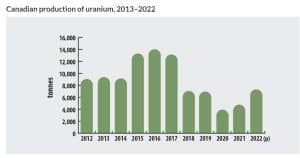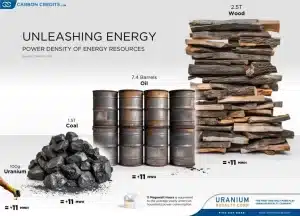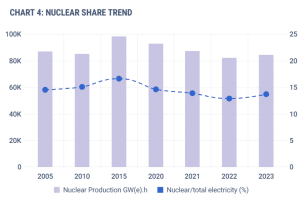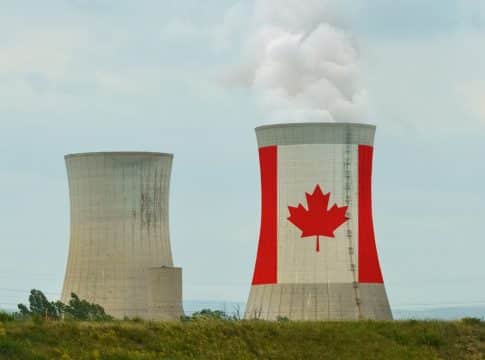Can Canada’s Uranium Reserves Transform it into a Nuclear Superpower?
Canada, already the world’s second-largest uranium producer, is experiencing a renewed surge in uranium mining. This momentum is driven by a global shift to nuclear energy as a cleaner solution to climate change. Canada’s resources, which supply over 20% of the world’s uranium demand, are vital for fueling nuclear energy worldwide.
Historically, most of Canada’s uranium output came from the eastern Athabasca Basin. But now, the western region is flourishing. Promising projects like Fission Uranium’s PLS and NexGen Energy’s Rook 1 are advancing quickly making the western Basin a future hub of Canadian uranium production.
Some other top companies ruling this region are IsoEnergy, Uranium Royalty Corp, and Cameco. These players are investing heavily in exploration and development, leveraging the Athabasca Basin’s rich uranium deposits to secure Canada’s role as a major nuclear fuel supplier.
Speaking about the nuclear sector, it is equipped with Canadian Deuterium Uranium (CANDU) reactors and SMRs. They support global emission reduction and energy security goals. By integrating all non-emitting energy sources, most significantly nuclear, Canada aims to reach net-zero emissions by 2050.
Check out Canada’s nuclear profile highlights according to IAEA :

Canada’s Uranium Comeback: NexGen Energy CEO Shares Insights
BBC recently rolled out a report where NexGen Energy CEO and Director, Leigh Curyer has analyzed the Canadian uranium potential and expressed his opinion.
He notes that several key moments helped drive nuclear energy’s resurgence in Canada and NexGen Energy’s success. In 2018, Bill Gates publicly endorsed nuclear power as “ideal for dealing with climate change,” drawing widespread attention to its low-carbon benefits. Four years later, former UK Prime Minister Boris Johnson championed a policy aimed at generating at least 25% of the UK’s energy from nuclear sources.
Moving ahead, uranium prices have surged by more than 200% making it the world’s top-performing commodities. Consequently, NexGen’s Rook 1 project, located in the Athabasca Basin, could soon push Canada to become the world’s leading uranium producer. The company anticipates that once its mine is operational, it will boost that to 25%, which can surpass Kazakhstan’s uranium potential.
Curyer and other leaders in the uranium mining industry strongly believe that the next few years are crucial for the thriving uranium industry in Canada. The approval process for new mines is lengthy, sometimes taking a decade from exploration to production.
They estimate that failure to bring these projects online could lead to a uranium shortage. Consequently, driving up power costs globally.

Source: Natural Resources: Govt of Canada
Athabasca Basin: Canada’s High-Grade Uranium Hub Sees New Investment Surge
The Athabasca Basin’s appeal has attracted major players, including Cameco and Uranium Royalty Corp, as well as numerous newcomers to the region.
A recent significant event was Uranium Royalty Corp.’s acquisition of a royalty on the Millennium and Cree Extension Uranium Projects located in Saskatchewan. The company purchased this royalty from a third-party industrial gas firm for $6 million.
Canadian mining companies like NexGen and Cameco are highly optimistic and they aim to meet rising uranium demand as many countries commit to tripling nuclear energy output by 2050.
Saskatchewan’s uranium-rich terrain is attracting investors which is pushing Canada to the nuclear forefront. The industry, along with its investors, remains hopeful that this time the demand will be sustained in the long-term. With rising interest and substantial backing, the western Athabasca can be a global hotspot for uranium production.
________________________________________________________________________
Uranium Royalty Corp.: Powering Decarbonization with Nuclear Efficiency
The only pure-play uranium royalty company is focused on capturing value from uranium price shifts through strategic investments. These include royalties, streams, debt, equity in uranium companies, and even physical uranium holdings. Notably, the company is growing with the rising demand for uranium.
- IEA revealed that in the U.S. alone, nuclear energy supplied roughly 19% of total electricity in 2022 and accounted for 55% of the nation’s carbon-free electricity.
- This nuclear output mitigated around 482 MMT of CO₂ emissions, which is equivalent to taking 107 million gasoline-powered vehicles off the roads.
More Power per Punch: Nuclear Energy Outshines Fossil Fuels

________________________________________________________________________
“With Great Power Comes Great Responsibility”
Nuclear power, even though has minimal carbon emissions has faced resistance from environmentalists.
The BBC report also explained the existing and forthcoming challenges that might cross the path of Canada’s nuclear journey. Critics argue that nuclear projects take too long and cost too much, often making them an unviable solution for urgent climate needs.
Over the past two decades, more than 100 nuclear plants have closed, including several in Canada and the U.S., mainly due to high costs and environmental concerns. Even British Columbia having substantial uranium deposits has banned nuclear plants and mining since 1980 voicing similar worries.
Environmentalists are also concerned about the radioactive waste and the risk of accidents like Fukushima, which released radioactive material and caused mass evacuations. However, experts, advocates, and mining veterans argue that modern technology has significantly improved nuclear safety.
In this perspective, Cameco CEO Tim Gitzel insists that the industry has learned from past mistakes and is prepared to meet growing energy demands safely and more responsibly. This is why the saying goes “With great power comes great responsibility.”
Rafael Mariano Grossi Director General, IAEA at COP29’s Nuclear Energy for Clean Energy Transitions session said,
“Pro-environment and pro-nuclear, they are already changing minds with science, courage, and a clear call for climate action. It’s high time all leaders listen — and more than that, act.”
 Source: IAEA
Source: IAEA
With its high-grade uranium deposits in the Athabasca Basin, Canada is well-positioned to meet the growing global demand for clean energy. Furthermore, this could reduce reliance on Russian imports and establish Canada as a nuclear “superpower.“ Overall, the potential is clear, and the path forward is promising for both Canada’s energy future and sustainability goals.
Disclosure: Owners, members, directors, and employees of carboncredits.com have/may have stock or option positions in any of the companies mentioned: UROY.
Carboncredits.com receives compensation for this publication and has a business relationship with any company whose stock(s) is/are mentioned in this article.
Additional disclosure: This communication serves the sole purpose of adding value to the research process and is for information only. Please do your own due diligence. Every investment in securities mentioned in publications of carboncredits.com involves risks that could lead to a total loss of the invested capital.
Please read our Full RISKS and DISCLOSURE here.
The post Can Canada’s Uranium Reserves Transform it into a Nuclear Superpower? appeared first on Carbon Credits.



